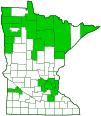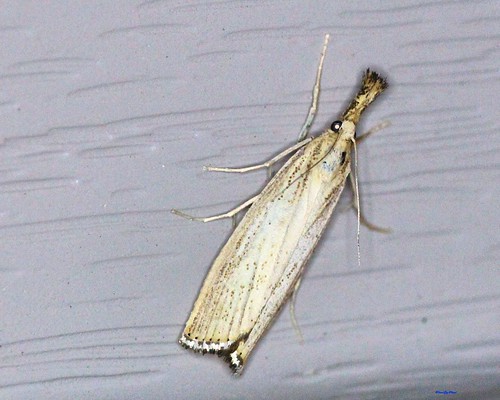lesser vagabond sod webworm moth
(Agriphila ruricolellus)
Conservation • Description • Habitat • Ecology • Distribution • Taxonomy
|
||||||||
| Hodges # | 5399 |
|||||||
Conservation Status |
||||||||
| IUCN Red List | not listed |
|||||||
| NatureServe | NNR - Unranked SNR - Unranked |
|||||||
| Minnesota | not listed |
|||||||
Description |
||
Lesser vagabond sod webworm moth is the ungainly common name for a common, small, late season, grass-veneer. It occurs in the United States east of the Great Plains, in northern Idaho, and in western Montana. There are just a few scattered records in the U.S. outside of this range. It also occurs across southern Canada from Newfoundland and Labrador to Alberta. The larvae feed on the roots of a variety of grasses, including corn, and on common sheep sorrel. Adults are active in August and September. They are found in a wide variety of habitats, including grassy areas, old fields, and cultivated fields. They are often reported in residential yards. Adults are narrow and ½″ (12 mm) in length. They have a ⅝″ to ¾″ (17 to 20 mm) wingspan. The head is yellowish. The finger-like sensory organs (palps) attached to the mouth are very long and densely hairy. They are projected forward, appearing like a hairy snout. The forewings are long and are squared at the tip. The outer margin is slightly convex. They are very pale yellowish with dark reddish-brown speckling that is more or less arranged in numerous streaks between the veins. The median line is a diagonal, diffuse band that is usually conspicuous. The subterminal line is similar but narrower. It is usually incomplete and is often inconspicuous or absent. The terminal line is represented by a series of black dots between the veins. The fringe is white or gold colored, but it is often black or dark brown at the base. The hindwings are yellowish. |
||
Size |
||
Total length: ½″ (12 mm) Wingspan: ⅝″ to ¾″ (17 to 20 mm) |
||
Similar Species |
||
Habitat |
||
A wide variety of habitats, including grassy areas, old fields, cultivated fields, and residential yards |
||
Ecology |
||
Season |
||
One generation per year. |
||
Behavior |
||
|
||
Life Cycle |
||
Larva overwinter. |
||
Larva Food |
||
A variety of grasses and common sheep sorrel |
||
Adult Food |
||
|
||
Distribution |
||||
|
Sources Mound Spring Prairie SNA Bioblitz, Species found August 11, 2018 (preliminary data), Minnesota Department of Natural Resources |
|||
| 12/7/2023 | ||||
Occurrence |
||||
Common |
||||
Taxonomy |
|||
Order |
Lepidoptera (Butterflies and Moths) | ||
Superfamily |
Pyraloidea (Pyralid and Crambid Snout Moths) | ||
Family |
Crambidae (Crambid Snout Moths) | ||
Subfamily |
Crambinae (Grass-veneers and Allies) | ||
Tribe |
Crambini (Grass-veneers) | ||
Genus |
Agriphila | ||
Synonyms |
|||
Agriphila ruricolella Crambus canadellus Crambus ruricolellus |
|||
Common Names |
|||
lesser vagabond sod webworm (larva) lesser vagabond sod webworm moth (adult) |
|||
Though awkward, the common name is descriptive. Lesser refers to the size of the moth, distinguishing it from the larger vagabond sod webworm moth (Agriphila vulgivagella). It has a wingspan of 17-20 mm compared to the larger species’ 22-28 mm wingspan. Vagabond describes the moth's widespread distribution and lack of a specific habitat. It can be found in various grassy areas, weedy fields, farmland, and even backyards. Sod Webworm indicates the family or group to which the moth belongs. Sod webworms are a group of insects whose larvae feed on grasses, creating webs in the thatch of lawns. The term “sod webworm” is descriptive of the larval behavior rather than the adult moth. Sod refers to the moth's larval stage, which feeds on the roots and stems of grasses, particularly those forming sod. This can cause damage to lawns and other turfgrass areas. Webworm describes the larvae’s behavior of constructing silken tubes or webs around themselves for protection while feeding on grass roots. Moth: This is the general term for the adult stage of the insect, characterized by having wings covered in scales and undergoing complete metamorphosis. Therefore, the common name “lesser vagabond sod webworm moth” provides a concise and descriptive picture of this moth’s size, habitat preference, larval behavior, and adult form. (Thank you Bard!) |
|||
Glossary
Palp
Short for pedipalp. A segmented, finger-like process of an arthropod; one is attached to each maxilla and two are attached to the labium. They function as sense organs in spiders and insects, and as weapons in scorpions. Plural: palpi or palps.
Visitor Photos |
|||||
Share your photo of this insect. |
|||||
| This button not working for you? Simply email us at info@MinnesotaSeasons.com. Attach one or more photos and, if you like, a caption. |
|||||
Babette Kis |
|||||
Agriphila ruricolellus lesser vagabond sod webworm moth Agriphila ruricolellus, lesser vagabond sod webworm moth, Barnes Prairie, Racine Co., WI. Photo was taken on August 20, 2020. These small grass veneer moths seem to fly close to the ground, which makes picture-taking difficult. |
 |
||||
MinnesotaSeasons.com Photos |
|||||
|
|||||

Visitor Videos |
|||
Share your video of this insect. |
|||
| This button not working for you? Simply email us at info@MinnesotaSeasons.com. Attach a video, a YouTube link, or a cloud storage link. |
|||
Other Videos |
|||


Created: 12/7/2023
Last Updated:



